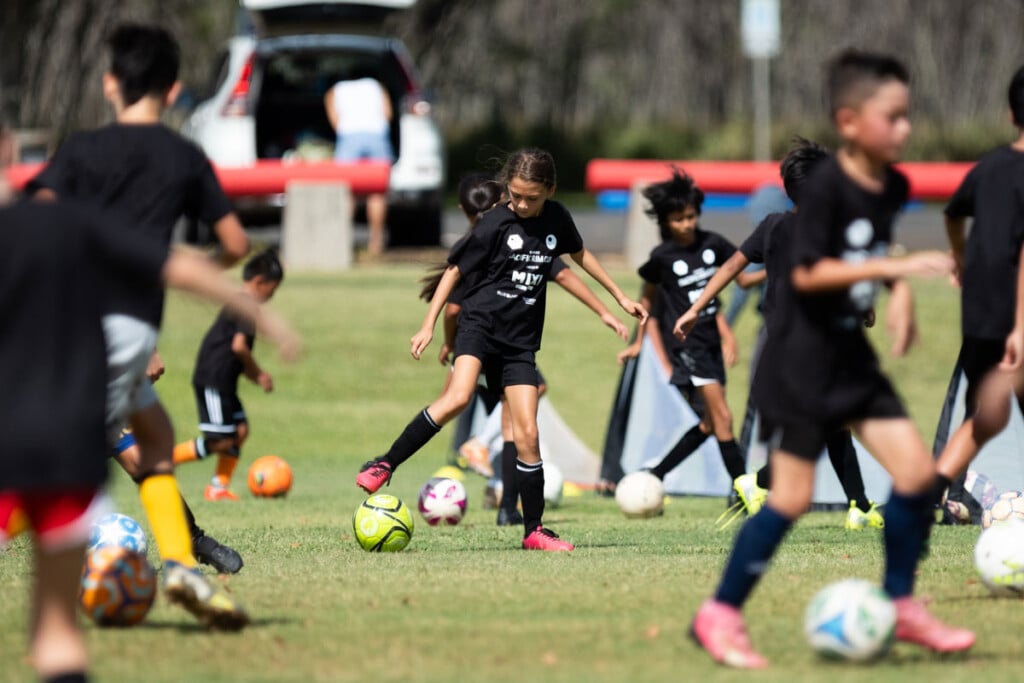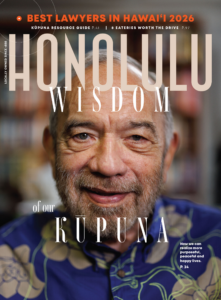Going Pro Isn’t for the Feeble
Hawai‘i has an abundance of elite athletes vying for sports glory despite the odds of success.
During the two decades I lived away from Hawai‘i, I worked primarily as a journalist for various media companies. One career deviation, however, was the time I spent working for the ATP, the organization that runs men’s professional tennis globally.

Participants practiced with professional soccer players at a youth soccer clinic, held in July at Waipi‘o Peninsula Soccer Complex. Photo: Anthony Consillio
I played tennis as a kid and teenager, and while I wasn’t a top player with college prospects, I loved the game. So, while living in New York many years later, I reached out to ATP’s communications director to inquire about working there. He told me if I wanted to talk about a job, I could come to Lisbon, Portugal, where he was working a tournament. I flew out that week and not long after, ended up with a communications position at ATP’s Ponte Vedra Beach, Florida, headquarters.
It was a dream job. I got to travel to tennis tournaments around the world, working behind the scenes. To this day, I’ve never had a more demanding job, but it was thrilling. I intersected not just with top players, but with those competing in the qualifiers—guys gunning for spots in the main draw. To even compete in the qualifiers, lower-ranked players from around the world had to play the “futures” and “challengers” events that are pathways for players to rack up wins to compete on the ATP Tour. These lower-tiered matches aren’t the high-profile events you see on TV; sometimes, they resemble junior tournaments with a few spectators watching from bleachers.
The thing that struck me was how incredibly good these lower-ranked players were. Their serves, forehands, backhands—all mind-blowing. Many of them, however, never make it to the ATP or other top-tier tournaments. And if they happen to advance to the bigger stage, they often lose in the early rounds, failing to win enough prize money to even cover their travel expenses. The competition in these qualifiers, and in the ATP itself, is intense, to say the least, and I quickly learned that being a professional tennis player, no matter how excellent you may have been as a junior or in college, is often a financial and emotional grind.
That’s what I thought about while editing this month’s cover story by Don Wallace about the oft-pursued path to pro sports. Hawai‘i has so many amazing athletes, unbelievably good, and with this promising pipeline of talent emerging at the earliest ages, it’s no wonder so many dream of sports glory.
But success is more than elusive. Many of our best athletes aren’t good enough to play at the highest levels of college sports, and even if they do succeed as college athletes, most drop off the radar after attempting to go pro. Yet it remains a burning aspiration not just for young athletes, but their parents. Kids barely out of diapers are out there on soccer and baseball fields, showing fierce determination as their parents watch intently from the sidelines. Families of standout young athletes often spend their savings traveling to get them in front of recruiters or college coaches.
Why do so many local kids pursue this amid the slim odds? As Don found, the reasons are varied. Funding college away from the Islands may be one, and as we all know, the financial rewards of athletic success can be extremely lucrative. There’s also the sheer passion for sports. Dreams are fueled by talent, and it’s only human to want to showcase that talent at the highest level. So the path to pro remains one of our community’s high aspirations—a journey fraught with challenges but rich with hope, with winners and many more contenders.
Diane Seo is the editorial director of HONOLULU Magazine.










